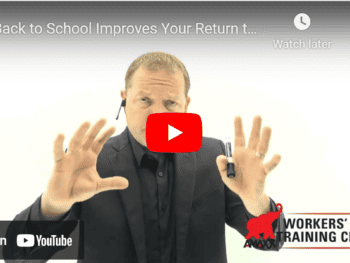Most Employers Have Poor Advanced Planning for Injuries
There are several different strategies an employer can utilize to return injured employees to work as quickly as the employee is medically able to do so. Unfortunately, many employers wait until they have an injured employee before they think about return to work methods that can be used. The approach of ‘we will make the injured employee a receptionist and have him/her answer the phone’ does not provide the employer with much productivity from the injured employee. This approach also comes up short if the employer has two or more injured employees at the same time.
There is a better approach. We strongly recommend for the employer to prepare for future injuries by having a transitional duty return to work program in place before it is needed. A transitional duty job program will significantly reduce the lost productivity caused by a workers’ compensation injury and will decrease the work claim cost, both indemnity and medical expense.
Transitional Duty
The transitional duty program provides modified duty jobs to the injured employee, modified jobs the employee can perform while the employee recovers from his/her injury. By anticipating the future need for a transitional duty program you can prepare for when an injury occurs.
An established transitional duty program will expedite the employee’s return to work, especially in situations where the employee does not want to return to work. The established transitional duty program can also serve as a counterbalance to when the employee has retained an attorney, and the attorney is trying to keep the employee off work in an effort to drive up the claim’s settlement value.
Create Bank of Transitional Duty Jobs
The first step is to create a job bank of modified duty / transitional duty jobs. By studying your prior history of injury claims you can identify the type of injuries that occur most often and prepare transitional duty jobs for them. For instance, the most common injury situation is the strain/sprain back claim. Often the medical provider will allow the employee to return to work as long as they do not lift over X pounds or bend or twist. The employer can prepare for this situation by reviewing the different jobs where back injuries might occur and studying how each job can be modified to eliminate lifting/bending/twisting.
A second most common injury situation is a hand/arm/shoulder injury with the medical provider restricting the use of the body part. The employer can again review their various jobs and analyze how each job might be performed using only one hand.
Create Wish List of Projects & Tasks
Another way to create or establish transitional duty jobs is to have your supervisors and department managers create their wish list of work, projects and tasks they would like to accomplish, but have not completed because of lack of personnel. The injured employee can often do tasks that need to be accomplished, but get delayed because no one is available to do them.
If your state allows you to select the medical provider for the injured employee, your chosen medical providers should be educated that you always have modified duty jobs available for the employee. If the employee selects the medical provider, a telephone call to the medical provider’s office should be made to advise your company has transitional duty jobs available. A list of potential jobs, with the general physical requirements of each job, should be faxed to the employee’s medical provider for the doctor’s review, prior to the employee’s appointment.
Success Requires Management Participation
When the employee arrives on the first day of the modified duty job, the employee’s supervisor or manager should meet with the employee. This gives the supervisor or manager the opportunity to explain how important the employee is to the company, to reassure the employee that their job is not in jeopardy, to explain carefully how the transitional duty job differs from the employee’s prior responsibilities and that the transitional duty job is within all work restrictions stated by the medical provider.
The details of the transitional duty job assigned to the injured employee should be conveyed to the workers’ compensation adjuster and to the nurse case manager assigned to the claim, if there is one.
If the injured employee’s regular job cannot be modified enough to comply with the work restrictions given by the medical provider, an option is to place the employee in a different job within their regular department, or to place them in a different job in another department. By having previously created a job bank of modified duty jobs, the placement of the employee in a position within the employee’s medical restrictions is made much easier.
Return to Work Placement Companies Can Assist
Return to Work placement companies can often assist a small employer who is unable to modify the work performed to accommodate the injured employee. Return to Work placement companies normally work with non-profits or charitable organizations to place the employee in a light duty job. This keeps the employee active and reduces the physical deconditioning injured employees often incur.
Through this article we have discussed the return to work strategies and discussed different approaches to transitional duty jobs. A slightly different perspective should be taken with the employees. Instead of referring to your transitional duty return to work program, name your transitional duty program “the remain at work program”. This removes the assumption that an injury claim can result in time off work and emphasizes the intent of allowing all injured employees to remain on the job.
By having a transitional duty program in place, all injured employees will know prior to an injury ever occurring that the employer expects them to return to work as soon as they are medically able to do so. The employee will benefit by remaining active and achieving a higher level of income, and the employer benefits by reduced workers’ compensation claims cost and higher employee productivity.
Author Rebecca Shafer, JD, President of Amaxx Risk Solutions, Inc. is a national expert in the field of workers compensation. She is a writer, speaker, and publisher. Her expertise is working with employers to reduce workers compensation costs, and her clients include airlines, healthcare, printing/publishing, pharmaceuticals, retail, hospitality, and manufacturing. She is the author of the #1 selling book on cost containment, Workers Compensation Management Program: Reduce Costs 20% to 50%. Contact:RShafer@ReduceYourWorkersComp.com.
Editor Michael B. Stack, CPA, Director of Operations, Amaxx Risk Solutions, Inc. is an expert in employer communication systems and part of the Amaxx team helping companies reduce their workers compensation costs by 20% to 50%. He is a writer, speaker, and website publisher. www.reduceyourworkerscomp.com. Contact: mstack@reduceyourworkerscomp.com.
©2012 Amaxx Risk Solutions, Inc. All rights reserved under International Copyright Law.















